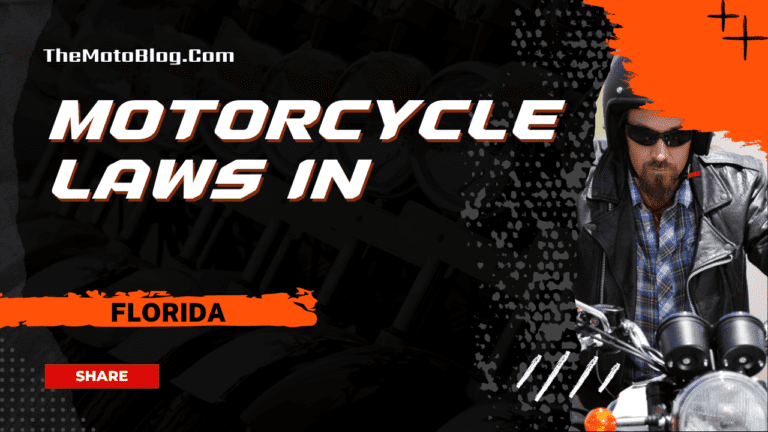Motorcycle Laws in Alabama: A Comprehensive Guide for Riders
When it comes to riding a motorcycle in Alabama, there are specific laws and regulations you need to be aware of. Alabama is one state that requires every motorcyclist and passenger to wear a safety helmet, regardless of age or experience. This law isn’t just for your own protection; it’s also part of the state’s comprehensive strategy to reduce fatalities and serious injuries on the road.
In addition, Alabama has its own set of rules regarding motorcycle endorsements – essentially, an additional qualification you’ll need on your driver’s license to legally ride. For instance, individuals under 16 can only operate motorcycles with engines less than 150cc. Also worth noting is that lane splitting – the practice of driving between lanes of stopped or slow-moving traffic – remains illegal in this southern state.
By understanding and adhering to these laws, not only will you stay within legal bounds when cruising on your two-wheeler, but you’ll also drastically enhance your safety while enjoying Alabama’s scenic routes.
Key takeaways
- In Alabama, it is mandatory for all motorcyclists and passengers to wear a helmet that meets DOT standards, regardless of age or experience.
- The practice of lane splitting – driving between lanes of stopped or slow-moving traffic – is illegal in Alabama.
- Motorcycles must have at least a left-side mirror; handlebars should not be over 15 inches from the seat height, and they require a muffler.
- Turn signals are only necessary if the motorcycle was manufactured after 1972.
- A Class M endorsement, which requires passing knowledge and skills tests, is needed on the driver’s license to legally operate a motorcycle.
- Riders under 14 are not allowed as motorcycle passengers.
- Alabama state law Section 32-5A-245 mandates the use of approved protective eyewear for all motorcycle riders.
- Motorcyclists must have a minimum liability insurance of $25,000 for bodily injury per person, $50,000 for total bodily injury, and $25,000 for property damage.
- Penalties for violating motorcycle laws in Alabama can result in fines ranging from $25 to $500. Repeat offences can lead to imprisonment and/or license suspension.
- Adherence to these and all Alabama motorcycle laws enhances rider safety.
Motorcycle laws in Alabama cover a broad spectrum of safety regulations, including helmet requirements for all riders, guidelines on proper eye protection, and rules for carrying passengers. The neighboring states have their own distinct approaches to motorcycle safety. For example, Georgia’s motorcycle laws stress the importance of proper lighting and handlebar height, while motorcycle laws in Tennessee focus on helmet usage for all riders and noise restrictions. Mississippi’s motorcycle laws include comprehensive guidelines on headlights and mirrors, unlike Florida’s motorcycle laws, where regulations on footrests and passenger seats are more pronounced. To the northwest, motorcycle laws in Mississippi regulate helmets for riders under 18 and lane usage. Understanding the nuances of motorcycle laws in Alabama and the surrounding states ensures that riders comply with regional regulations, fostering a safer and more responsible riding culture across the southeastern United States.
Understanding Alabama’s Motorcycle Laws
Motorcycle laws vary from state to state. Here in Alabama, they’re designed to keep all road users safe and sound. Let’s dive into the specifics of what these rules entail for motorcycle enthusiasts in the Heart of Dixie.
First off, it’s mandatory for all riders and passengers to wear helmets. This isn’t a light suggestion – it’s the law! Helmets need to meet Department of Transportation standards. So make sure when you’re picking out your headgear, it has that DOT sticker on the back.
Next up is eye protection. While not as strict as helmet regulations, Alabama encourages its riders to use either a windscreen, goggles or safety glasses while riding. It’s all about minimizing risks associated with debris or insects hitting your eyes at high speeds.
In terms of motorcycle equipment requirements, let’s take a look at some important details:
- Your bike needs one mirror (left side), but having two is always better.
- Handlebars can’t be more than 15 inches above the seat height.
- Turn signals aren’t required unless your bike was manufactured after 1972.
- Mufflers are compulsory; however, cutouts or bypasses are prohibited.
Passenger restrictions also play an essential role in Alabama’s motorcycle laws. Riders under 14 aren’t allowed as passengers on motorcycles without sidecars or enclosed cabs.
Lastly, let me mention lane splitting – currently illegal in Alabama. Despite being a topic of hot debate among bikers across states where it remains banned, my advice is simple: stick to the law.
| Requirement | Law |
|---|---|
| Helmet | Mandatory |
| Eye Protection | Recommended |
| Mirror | Mandatory (at least one) |
| Handlebar Height | Not more than 15 inches above seat |
| Turn Signals | Necessary if manufactured after 1972 |
| Mufflers | Mandatory |
The Importance of Motorcycle Endorsement in Alabama
Understanding the motorcycle laws in any state is crucial, but let’s take a moment to delve into one pertinent aspect – the significance of a motorcycle endorsement in Alabama.
Alabama requires that anyone operating a motorcycle must have a “Class M” endorsement on their license. This isn’t just some formality, it’s important for several reasons.
Firstly, getting this endorsement ensures you’ve passed both knowledge and skills tests specifically designed for motorcyclists. These tests are meant to gauge your understanding of safety rules and driving techniques that are unique to motorcycles.
Secondly, having an official endorsement also means you’re legally allowed to ride on public roads. Without it, you’re technically breaking the law every time you mount up and could face penalties if caught.
Let’s break down the numbers:
| Test | Pass Rate |
|---|---|
| Knowledge Test | 65% |
| Skills Test | 70% |
From these figures, we can see that not everyone who attempts these tests passes right away – they’re deliberately challenging to ensure only competent riders receive endorsements.
Now let’s look at why this matters beyond personal safety and obeying traffic laws:
- It can significantly affect your insurance rates. Most insurers offer lower premiums for riders who have completed their Class M endorsement.
- If involved in an accident without an endorsement, it could complicate legal matters or claims processing with your insurance company.
Helmet Laws in Alabama: What You Need to Know
If you’re a rider in Alabama, it’s crucial that you familiarize yourself with the state’s helmet laws. The law is simple and clear-cut; all motorcycle riders and passengers are required to wear helmets. Unlike some other states, there isn’t an age cutoff or any exceptions based on years of riding experience. In Alabama, if you’re on a bike, you need a helmet.
Now, there’s more to this than just simply wearing any old helmet. It can’t be just any headgear – it has got to meet certain safety standards set by the Department of Transportation (DOT). This implies that your helmet should have DOT certification. Helmets without this certification might not provide sufficient protection during accidents.
Moreover, the law also mandates additional equipment for nighttime riding. For example:
- Your motorcycle must have a light visible from at least 200 feet away.
- No matter what time of day it is, your bike needs both rearview mirrors.
Failure to adhere to these laws can land you in trouble with fines or even suspension of driving privileges. Here’s how penalties stack up:
| Violation | Fine |
|---|---|
| First-time offence | $100 |
| Second-time offence | $200 |
Eye Protection and Clothing Requirements
When you’re hitting the open road in Alabama, it’s crucial to know what gear you need. After all, safety is paramount when it comes to motorcycling. And, believe me, Alabama has some specific laws concerning this matter.
According to Alabama State Law Section 32-5A-245, eye protection is mandatory for all riders. It doesn’t matter if you’re the driver or just a passenger – those eyes better be covered! The law specifically states that individuals shall not operate a motorcycle unless they are wearing protective eyewear approved by the Department of Public Health.
Here’s a little breakdown of what this means:
| Department | Requirement |
|---|---|
| Department of Public Health | Approved Protective Eyewear |
Now let’s talk about clothing requirements. Interestingly enough, there isn’t any explicit law in Alabama that mandates certain types of clothing while riding your motorcycle. However, I can’t stress enough how important it is to wear proper attire for your own safety.
Consider these suggestions:
- Wear a helmet even though it’s not required for those above 21.
- Leather jackets and pants can protect against road rash.
- Gloves will keep your hands safe and warm.
- Motorcycle boots shield your feet during an accident.
Remember, just because something isn’t legally required doesn’t mean it’s not critical for your safety on the road.
Lane Splitting Rules in Alabama
When it comes to motorcycle laws, one of the most debated topics is lane splitting. I’ve done some digging into Alabama’s stance on this matter and here’s what I found. In Alabama, lane splitting is not permitted. This rule means that motorcyclists aren’t allowed to ride between lanes or rows of slow moving or stationary vehicles.
It’s well known that many motorcyclists use lane splitting as a way to navigate through traffic more efficiently, especially in heavy congestion. But if you’re riding your bike in the Heart of Dixie, you’ll need to avoid this maneuver or face penalties.
Here are a few key points about Alabama’s lane splitting rules:
- It applies equally across all types of roadways.
- Motorcycles are expected to occupy a full lane just like any other vehicle.
- There are penalties for violation which could include fines and points against your driving record.
Now, let me give you an idea about how these penalties look like:
| Violation | Fine | Points Against Driving Record |
|---|---|---|
| First Offense | $20-$200 | 2 |
| Second Offense within two years | $50-$500 | 3 |
I also want to mention something important – there’s often confusion about the difference between “lane splitting” and “lane sharing”. While it might seem similar at first glance, they’re actually different practices. Lane sharing refers to two motorcycles occupying the same single lane side by side and this practice is permitted under Alabama law.
Passenger Regulations for Motorcycles
If you’re riding a motorcycle in Alabama, it’s important to understand the laws surrounding passengers. One key requirement is that your bike must have a permanent and regular seat attached if you’re carrying a passenger. In other words, passengers can’t perch on the handlebars or anywhere else that isn’t designed for seating.
Additionally, any passenger must be at least 14 years old. But there’s more to it than just age restrictions. Regardless of their age, passengers are required to wear helmets approved by the U.S Department of Transportation (DOT). Helmets not only protect riders from potential head injuries but also significantly reduce the risk of fatality during accidents.
Here’s a quick rundown of these rules:
- Motorcycle must have a regular seat
- Passenger should be at least 14 years old
- Both driver and passenger need DOT-approved helmets
Regarding equipment, Alabama law requires motorcycles to possess footrests for passengers. If you plan on having someone ride with you regularly, it might be worth investing in high-quality adjustable footrests. Remember: comfort is crucial when it comes to long rides!
Helmet straps are another non-negotiable aspect under Alabama law. Your helmet needs sturdy straps that keep it securely fastened while on the move.
The law also stipulates that passengers must sit behind the operator or in a sidecar – no exceptions! Sidecars should ideally have safety harnesses or restraints to ensure maximum security.
To sum up:
- Motorcycles need passenger footrests
- Securely fastened helmets with strong straps are mandatory
- Passengers sit behind operator or in sidecar
How Traffic Violations Affect Motorcyclists
Traffic violations have a significant impact on motorcyclists in Alabama. Whether it’s running a red light, speeding, or reckless driving, each violation carries its own set of penalties. These aren’t just fines and points on your license; they can also lead to higher insurance premiums and even suspension of your motorcycle endorsement.
Speeding is one of the most common traffic violations for motorcyclists. In Alabama, if you’re caught going above the speed limit, you can expect to pay hefty fines. The fine amount varies depending on how much over the limit you were traveling:
| Over Speed Limit | Fine Amount |
|---|---|
| 1 – 25 mph | $100 – $500 |
| 26+ mph | $200 – $600 |
Moreover, if you accrue too many points from violations in a short period of time, there are harsher consequences. Here’s what I mean:
- 12-14 points within 2 years – Your license could be suspended for up to 60 days
- 15-17 points within 2 years – Your license might be suspended for up to 90 days
- More than 18 points within 2 years – You risk losing your license for at least a year
It’s worth noting that these penalties apply to all drivers – not just motorcyclists. However, because motorcycles are often more difficult for other drivers to see and because their riders are more vulnerable in an accident, traffic violations by motorcyclists can carry additional risks.
Reckless driving is another serious offense in Alabama. A first-time offender may face fines between $25 and $500, as well as possible imprisonment or mandatory attendance at a state-approved driver training program.
Insurance Policies for Motorcyclists in Alabama
When it comes to motorcycle laws and insurance policies, Alabama has specific requirements that every rider must meet. First and foremost, all motorcyclists are required by law to have liability insurance. The reason behind this is straightforward: it protects you financially if you’re at fault in an accident.
Let’s talk about the minimum coverage limits. In Alabama, these include $25,000 for bodily injury per person, $50,000 for total bodily injury if multiple people are injured in the accident, and another $25,000 for property damage. Here’s a simple breakdown:
| Coverage Type | Minimum Limit |
|---|---|
| Bodily Injury Per Person | $25,000 |
| Total Bodily Injury (Multiple People) | $50,000 |
| Property Damage | $25,000 |
It’s important to remember that while these are the state-mandated minimums, you may want to consider getting more coverage. This is because if damages exceed your policy limit after an accident occurs – whether it involves another vehicle or not – you’ll be responsible for paying any additional costs out of pocket.
While we’ve covered the basics of what’s required by law in terms of motorcycle insurance in Alabama, there are several other types of coverages available as well:
- Collision Coverage: This covers damage to your own bike from a collision with another vehicle or object.
- Comprehensive Coverage: This provides protection against theft or damage caused by something other than a collision like fire or weather-related incidents.
- Uninsured/Underinsured Motorist Protection: If someone without sufficient insurance hits you on the roadways of Alabama – this coverage will handle costs associated with injuries or damages.
Penalties for Breaking Motorcycle Laws in Alabama
If you’re a motorcycle enthusiast like me, you’ll want to be well aware of the consequences of breaking motorcycle laws in Alabama. Non-compliance can lead not only to hefty fines but also to serious repercussions like license suspension. So, let’s delve into the specific penalties that riders might face.
For starters, riding without a helmet is considered a serious offense in Alabama. The fine for this breach of law typically ranges from $25 to $100.
Motorcyclists who fail to adhere to lane splitting laws also face penalties. In Alabama, lane-splitting (riding between lanes of slow-moving or stationary traffic) isn’t permitted and could result in a fine up-to $500.
Moreover, if you’re caught operating your bike without the required Class M license, the penalty can be severe. Fines range from $50-$200 and/or imprisonment for 10-30 days on first violation.
Here’s an overview:
| Violation | Fine | Other Penalties |
|---|---|---|
| Riding without Helmet | $25 – $100 | None |
| Lane Splitting | $0 – $500 | None |
| Riding Without Class M License | $50 – $200 | Imprisonment (10-30 days) |
Don’t forget about insurance requirements either! Operating a bike without proof of insurance could lead you down a treacherous road too: fines up-to $500 or even suspension of your registration and driving privileges.
Lastly, more severe offenses such as DUI carry hefty penalties too – including imprisonment and mandatory substance abuse treatment programs. This varies depending upon whether it’s your first offense or if there have been previous violations.
It’s crucial to follow these rules not only because they are enforceable by law but also because they aim at promoting safe riding practices for everyone on the road.
Conclusion: Staying Safe and Legal on the Road
Navigating Alabama’s motorcycle laws can seem like a daunting task. But let me assure you, it’s not as complex as it may first appear. In fact, understanding these laws is key to ensuring your safety while keeping you on the right side of the law.
Firstly, remember that helmets are mandatory for all riders in Alabama. It’s a simple rule but one that has been proven to save lives countless times over. Just make sure your helmet meets the Department of Transportation (DOT) standards.
Secondly, don’t underestimate the importance of having valid insurance coverage. The minimum liability insurance requirements in Alabama are:
- $25,000 for bodily injury or death of one person
- $50,000 for bodily injury or death of two or more persons
- $25,000 for property damage
These figures should serve as a bare minimum – additional coverage could be crucial if you find yourself in an accident.
Lastly, consider taking a Motorcycle Operator Training Course. Not only does this course offer valuable safety tips and techniques but also it can potentially lower your insurance premiums! Plus, becoming familiar with Alabama’s road signs and traffic rules will undoubtedly make you feel more secure and confident when riding.
To sum up my thoughts:
- Always wear a DOT-approved helmet
- Ensure you have adequate insurance coverage
- Consider taking a Motorcycle Operator Training Course
By adhering to these guidelines, I believe we’ll all contribute to making Alabama’s roads safer places for motorcyclists and other road users alike.
Motorcycle Laws in the US By States
If you liked this article, then please subscribe to our YouTube Channel for more Bike Videos. You can also find us on Instagram, Twitter and Facebook.
Disclosure: As an Amazon Associate, I earn from qualifying purchases. Read more about Amazon Affiliate Disclaimer.

Vishwanath Mathpati
I am Vishwanath Mathpati, a full-time Blogger and Motorcyclist from Bidar, Karnataka. I love writing about my Motorcycles Stories and Riding Gears on this blog.
Know More About Me.







